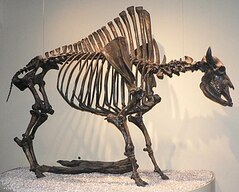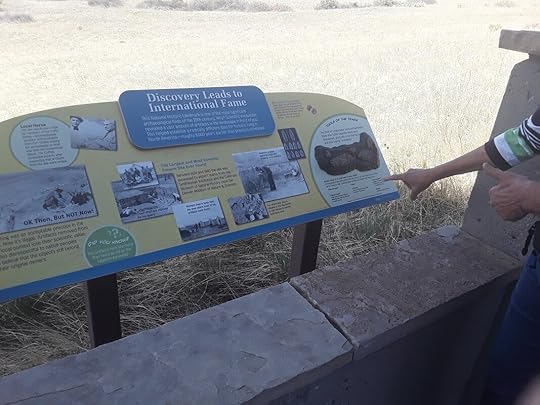The Lindenmeier Site

The Soapstone Prairie Natural Area is in central Colorado, just south of the Wyoming border. It has within it an archeological site that few know about, even though it is very important to our understanding of man in the Americas. The Lindenmeier Folsom Site is one of the hidden gems of American Prehistory.
 point from the Lindenmeier Site, 1934Folsom Man is the name given to a group of Paleo-Indian nomadic hunters who roamed throughout Central North America between approximately 9,000 BC and 4,000 BC. They are identified by their stone points, which have a distinct concavity on one side.
point from the Lindenmeier Site, 1934Folsom Man is the name given to a group of Paleo-Indian nomadic hunters who roamed throughout Central North America between approximately 9,000 BC and 4,000 BC. They are identified by their stone points, which have a distinct concavity on one side.Folsom Man is named after the small town of Folsom, New Mexico, In 1908, a devastating flood unearthed bison bones that were exceedingly large. It wasn’t until 1925, when scientists finally investigated the site, that stone points were found with the bones. The bones were determined to be those of bison antiquus, an ancestor of the modern bison that had died out approximately 10,000 years ago.
 Bison Antiquus. They were 25-30% larger than present day bison. Prior to the investigation of the Folsom Site, scientists believed that man had only been in North America for approximately 5,000 years.
Bison Antiquus. They were 25-30% larger than present day bison. Prior to the investigation of the Folsom Site, scientists believed that man had only been in North America for approximately 5,000 years. The Folsom Site is just a kill site. It contains bones and stone points, but there is no evidence of habitation, no campfires, no other tools or implements. Although it proved that man was in the Americas much earlier than previously supposed, it shed little light on who these people were.
 Working at the site with horses 1936
Working at the site with horses 1936In 1924, three amateur archaeologists, A. Lynn Coffin, his father, Judge Claude C. Coffin, and their friend, C. K. Collins were wandering through a ranch owned by William Lindenmeier, Jr.. They were walking through an arroyo when they discovered some fluted points that were very different from the more abundant and smaller arrow points they usually found. The points were some fifteen feet below the surface. That depth suggested that they were very old. They called in the Judge’s brother, Major Roy G. Coffin, who persuaded Dr. Frank Roberts of the Smithsonian Institution to visit in 1934. The Smithsonian Institution, supported by the Colorado Museum of Natural History, excavated the site between 1935 and 1940. The Coffin brothers also did some excavating of their own.
 The Coffins at the site 1935
The Coffins at the site 1935The well-preserved site is buried under twelve to fifteen feet of sediment and covered by layers of silts and clays slowly deposited by floods and windstorms over thousands of years. It contains clusters of stone and bone debris, strewn over at least a half-mile. These clusters represent work areas, where Folsom peoples manufactured projectile points, repaired or discarded broken tools, cooked their food, cleaned and transformed animal hides into leather, and manufactured clothing.Some archaeologists suggest that the clusters represent a single large camp simultaneously occupied by several large Folsom groups, each with twenty to forty members. These groups may have come together for a rendezvous or trade fair. Other archaeologists believe the clusters were laid down by a single group that returned year after year, generation after generation. Either way, the Lindemeier Site is the largest Folsom site yet found. It is still being excavated, and its secrets revealed.
 While the original Folsom site provided no tools except points, the Lindenmeier site shows that the Paleo-indians referred to as Folsom People created many types and shapes of tools. In addition to spearheads, archaeologists found wedge shaped scrapers and other tools made for chopping, slicing and skinning the hides of the bison. They also found scored pieces of hematite which were used to extract red ochre, believed to be used to paint for their faces or for ceremonial purposes. Highly polished 1-2”discs inscribed with designs were found at the site and are the oldest artwork found in Colorado.
While the original Folsom site provided no tools except points, the Lindenmeier site shows that the Paleo-indians referred to as Folsom People created many types and shapes of tools. In addition to spearheads, archaeologists found wedge shaped scrapers and other tools made for chopping, slicing and skinning the hides of the bison. They also found scored pieces of hematite which were used to extract red ochre, believed to be used to paint for their faces or for ceremonial purposes. Highly polished 1-2”discs inscribed with designs were found at the site and are the oldest artwork found in Colorado.
The site is listed on the National Register of Historic Places and is designated a National Historic Landmark. Artifacts from the site are held by the Smithsonian Institution, the Denver Museum of Nature and Science, the Fort Collins Museum of Discovery, and in private collections.
 There is not much to see at the Lindenmeier Site. A short paved trail leads to a covered overlook where visitors look out over the arroyo in which the excavations have occurred, but they are either hidden from view or so carefully reburied that they are not visible. The weather was cooler and wetter during the period when the Folsom men inhabited it, but it is still easy to look over the vastness of the rolling hills and envision what life might have been like so many millennia ago.
There is not much to see at the Lindenmeier Site. A short paved trail leads to a covered overlook where visitors look out over the arroyo in which the excavations have occurred, but they are either hidden from view or so carefully reburied that they are not visible. The weather was cooler and wetter during the period when the Folsom men inhabited it, but it is still easy to look over the vastness of the rolling hills and envision what life might have been like so many millennia ago. Soapstone Prairie has multiple trails for hiking, biking and horseback riding and is open for visitation from March 1 until November 30 each year. It is a habitat for bison, black-footed ferrets, pronghorn antelopes, and other native species.
https://fortcollinsimages.wordpress.com/2017/04/02/lindenmeier-a-folsom-man-site/
https://www.fcgov.com/naturalareas/finder/soapstone
 In the Shadow of Sunrise is an historical novel set during the Folsom Period. The characters in the novel shelter every winter in the San Luis Valley, but during the summers they go on long migrations, following the herds and collecting suitable rocks for making spear points and other tools. While these characters do not visit the Linenmeier Site in my story, they would have done so in other years, and some of the people who lived at this site would have met my characters at other sites that they visited. The information available about this site did a lot to inform how I structured my story. Jennifer Bohnhoff is a former middle school and high school history and language arts teacher. She lives in the mountains of central New Mexico and write historical and contemporary fiction for middle grade through adult readers. She is available to lecture on the history behind her stories.
In the Shadow of Sunrise is an historical novel set during the Folsom Period. The characters in the novel shelter every winter in the San Luis Valley, but during the summers they go on long migrations, following the herds and collecting suitable rocks for making spear points and other tools. While these characters do not visit the Linenmeier Site in my story, they would have done so in other years, and some of the people who lived at this site would have met my characters at other sites that they visited. The information available about this site did a lot to inform how I structured my story. Jennifer Bohnhoff is a former middle school and high school history and language arts teacher. She lives in the mountains of central New Mexico and write historical and contemporary fiction for middle grade through adult readers. She is available to lecture on the history behind her stories.The booklink in the above blog is for Bookshop.org, an online bookseller that gives 75% of its profits to independent bookstores, authors, and reviewers. If you click through my book lists and make a purchase on Bookshop.org, I will receive a commission, and Bookshop.org will give a matching commission to independent booksellers. But if you’re not looking to buy, ask your local library for a copy, and request that they buy one if they haven't already.
Published on January 26, 2025 13:11
No comments have been added yet.



